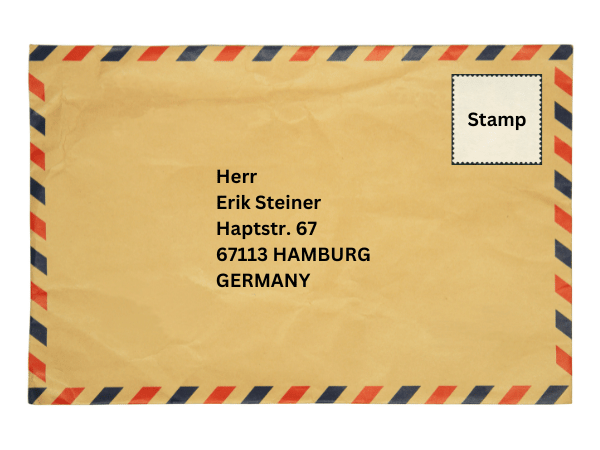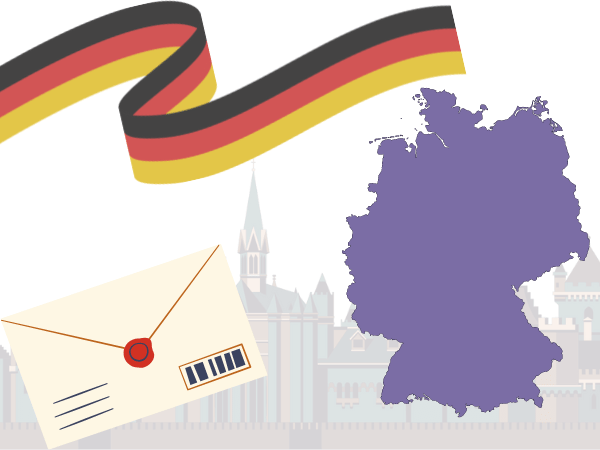Sending news in a letter is one of the most reliable ways to keep in contact, and gives the recipient tangible evidence that they are being thought of by someone else, somewhere else, far away. And if you are sending post to some a person living in Germany, your letter could not be in safer hands. Deutsche Post, the German equivalent of Royal Mail, is one of the largest and best service providers in the world, so there’s no better time to start new writing habits.
If you’re looking for the quickest and easiest way to send a real letter to Germany, let us do the heavy lifting. With e-Snail, you can send a physical letter to anywhere in the world.
Germany Address Format
Sending a letter to glorious Germany is not a difficult process. As long as you are careful and clear when formatting your recipient’s address, it will arrive quickly and in one piece.
Firstly, the recipient’s address, being the most important, needs to be written in the centre of the envelope space and needs to include all of the details highlighted below in order to get to where it needs to go. The top left corner of the envelope should have the sender’s details including name and address, personal or work. The top right corner needs to be kept clear and ready for the correct postage stamps to be stuck on.
Secondly, German mailing addresses are quite detailed and should be set out as follows:
- The top line of your address section can include the title or form of address of the recipient. This is optional but is more commonly used than not.
- Next line needs to clearly show the first and last name of the recipient of your letter. Include as much detail as possible here as your letter will be automatically returned without it!
- The following line should include the street or road on which they live first. Then the house/apartment or entrance door number. Note that, as in most European countries, the house or apartment number comes after the name of the street. Also, many apartments in Germany do not have their own individual number, rather, it is the name of the person which is used to allocate the post once it arrives at the house or apartment, hence the importance of the recipient’s name.
- With the first two digits indicating area and the next three indicating the postal district, the German five-digit postcode is important in ensuring quick and efficient delivery. Following this and on the same line, there should be the city or town name, preferably in capital letters.
- Finally, write the name of the country on your last line, also in capital letters.
When you’re finished, the address on your envelope should look something like this:
Germany Abbreviations & Symbols
Just as a title such as Mr or Mrs should be used when addressing letters for the Royal Mail, the same applies when sending a letter to Germany but, of course, using the German equivalents.
For a title or form of address, you may need to use Hr. or Hrn. – Herr or Herrn (Mr), Fr. – Frau (Mrs or Ms – this applies to any female over the age of 18, whether married or not), Frl. – Fräulein (Miss). There is no longer a German equivalent for ‘Master’ as in an accompaniment to ‘Miss’; a first initial or first name and surname are considered the safest option.
As well as abbreviations for titles, here are a few other abbreviations you may come across too.
- str. – straẞe (street or road)
- PLZ – Postleitzahl (post code)
- If you are sending a letter to someone living at another person’s address such as a student or friend (which is common in Germany), you may want to use p.Adr., per Adresse or the word ‘bei’ which means ‘c/o or care of’.
Prohibited and Restricted Items
Another thing which needs to be remembered if you are sending anything more than a letter to your pen pal in Germany, is exactly what can be sent and how. As always, it’s usually common sense.
It is strictly prohibited to send batteries of any kind, coins or ivory and its products into Germany. In addition, it is prohibited to send or take any goods which are deemed as being weapons, such as guns, bombs or swords and their parts and accessories. The same applies to illicit narcotics, drugs and corrosive substances.
When it comes to restricted items, that is those which need to be declared to the postal service before posting, the list includes alcohol, vegetables and their products, animal derivatives including foods, oils, leather and fur products, goods made of tropical wood, tobacco and computers and their parts and accessories.
Conclusion
You should have a much better idea of how to go about sending a letter or parcel to beautiful Germany, and there’s nothing stopping you from picking up your pen to start. Just remember to use this guide for the correct way to write and format the mailing address and to ensure that all prohibitions or restrictions are adhered to – then you’ll be ready to send your letter off on its journey with peace-of-mind that it will get to where you want it to go.
Don’t forget, you can also use e-Snail to easily send a real letter online to anywhere in the world.




